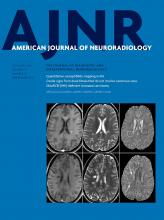Abstract
BACKGROUND AND PURPOSE: Detection of disease activity, defined as new/enlarging T2 lesions on brain MR imaging, has been proposed as a biomarker in MS. However, detection of new/enlarging T2 lesions can be hindered by several factors that can be overcome with image subtraction. The purpose of this study was to improve automated detection of new T2 lesions and reduce user interaction to eliminate inter- and intraobserver variability.
MATERIALS AND METHODS: Multiparametric brain MR imaging was performed at 2 time points in 36 patients with new T2 lesions. Images were registered by using an affine transformation and the Demons algorithm to obtain a deformation field. After affine registration, images were subtracted and a threshold was applied to obtain a lesion mask, which was then refined by using the deformation field, intensity, and local information. This pipeline was compared with only applying a threshold, and with a state-of-the-art approach relying only on image intensities. To assess improvements, we compared the results of the different pipelines with the expert visual detection.
RESULTS: The multichannel pipeline based on the deformation field obtained a detection Dice similarity coefficient close to 0.70, with a false-positive detection of 17.8% and a true-positive detection of 70.9%. A statistically significant correlation (r = 0.81, P value = 2.2688e-09) was found between visual detection and automated detection by using our approach.
CONCLUSIONS: The deformation field–based approach proposed in this study for detecting new/enlarging T2 lesions resulted in significantly fewer false-positives while maintaining most true-positives and showed a good correlation with visual detection annotations. This approach could reduce user interaction and inter- and intraobserver variability.
ABBREVIATIONS:
- BL
- baseline
- CIS
- clinically isolated syndrome
- DSC
- Dice similarity coefficient
- DF
- deformation fields
- FP
- false-positive
- FPf
- false-positive fraction
- FU
- follow-up
- PD
- proton density
- TP
- true-positive
- TPf
- true-positive fraction
- © 2016 by American Journal of Neuroradiology







